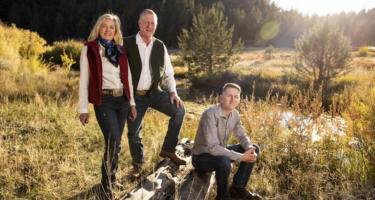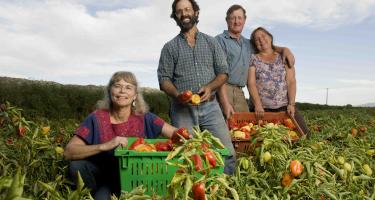Browse our Growing Library of Success Stories
By:
Working Lands for Wildlife Prescribed burns and strategic grazing practices have made the Nichols Ranch more profitable, as well as more productive for livestock and wildlife.
Prescribed burns and strategic grazing practices have made the Nichols Ranch more profitable, as well as more productive for livestock and wildlife.
By:
Working Lands for Wildlife
Landowners Tim and Sarah Bailey work with a conservation-minded ranch manager to keep South Dakota’s prairies intact and profitable for livestock grazing.
By:
Working Lands for Wildlife
Chris and Cole Mushrush are keeping grasslands tree-free on their ranch in Strong City, Kansas, and using virtual fencing to repair eroding soils.
By:
Working Lands for Wildlife This ranch in the Sandhills relies on healthy prairies to support two businesses: a tourist-based outfitting company and for feeding cattle.
This ranch in the Sandhills relies on healthy prairies to support two businesses: a tourist-based outfitting company and for feeding cattle.
By:
Working Lands for Wildlife GREAT PLAINS ‘GUARDIANS OF THE GRASSLANDS SERIES | Scott Westrup was one of the first landowners in Oklahoma to sign up for the NRCS Great Plains Grassland Initiative to get rid of trees infesting his pastures.
GREAT PLAINS ‘GUARDIANS OF THE GRASSLANDS SERIES | Scott Westrup was one of the first landowners in Oklahoma to sign up for the NRCS Great Plains Grassland Initiative to get rid of trees infesting his pastures.
By:
Working Lands for Wildlife “Little Miss Clearcut” is restoring the prairie with loppers and a handsaw to keep woody invaders from taking over her grassland pastures.
“Little Miss Clearcut” is restoring the prairie with loppers and a handsaw to keep woody invaders from taking over her grassland pastures.
By:
Ted WilliamsFish are cold, slimy, unfeathered, unfurred, unheard, and usually unseen by non-anglers. So for the general public, including much of the environmental community, fish don’t count as wildlife.
By:
Family Farm AllianceThis multi-generation family takes care of their livestock and ranch in a way that prioritizes the health of the land. They actively participate in conservation efforts and land stewardship programs, including conservation easements and river bank restoration projects in partnership with Fish and Wildlife. Preserving the integrity of their ranch and managing it responsibly is of utmost importance to them, and they have put considerable effort into estate planning to ensure its continued success.
By:
Ashley Pratt Sparling Ranch Conservation Bank creates a win-win for ranchers, developers, wildlife
Sparling Ranch Conservation Bank creates a win-win for ranchers, developers, wildlife
By:
Sage Grouse Initiative Research from an eight-year study in the Warner Mountains shows why strategically removing encroaching trees spells good news for sage grouse, a declining upland bird that serves as a benchmark for the overall health of the sagebrush biome. Researchers quantified a six-fold increase in sage grouse’s preferred habitat following woodland management and a population growth rate that was +12 percent higher in the treated area than in the control area without management.
Research from an eight-year study in the Warner Mountains shows why strategically removing encroaching trees spells good news for sage grouse, a declining upland bird that serves as a benchmark for the overall health of the sagebrush biome. Researchers quantified a six-fold increase in sage grouse’s preferred habitat following woodland management and a population growth rate that was +12 percent higher in the treated area than in the control area without management.
This adds to a growing list of research — much of it based on the long-term study in the Warners — that documents the myriad benefits of conifer removal for wildlife and grazing lands.
By:
Leopold Conservation Award Program An inspiring transformation at Witcher Creek Ranch is thanks to Marie and Glenn Nader’s willingness to think big and bold.
An inspiring transformation at Witcher Creek Ranch is thanks to Marie and Glenn Nader’s willingness to think big and bold.
Marie, Glenn, and their son, Alan, are dedicated to promoting water conservation and soil health on a working cattle ranch. They credit state and federal conservation-focused programs and grants with helping them make dramatic changes on their 2,880 acres of Modoc County.
By:
Leopold Conservation Award Program For Colby and McKenzie Pace, raising beef cattle includes keeping a sharp eye on preventing overgrazing and noxious weeds and seeking out ways to improve their land for nesting and migrating shorebirds. This forward-thinking approach to livestock and wildlife management earned the Coalville couple — and their Half Circle Cross Ranch — the 2020 Utah Leopold Conservation Award.
For Colby and McKenzie Pace, raising beef cattle includes keeping a sharp eye on preventing overgrazing and noxious weeds and seeking out ways to improve their land for nesting and migrating shorebirds. This forward-thinking approach to livestock and wildlife management earned the Coalville couple — and their Half Circle Cross Ranch — the 2020 Utah Leopold Conservation Award.
By:
Leopold Conservation Award Program Located northwest of Sacramento, Full Belly Farm is co-owned by Andrew Brait, Paul Muller, Judith Redmond and Dru Rivers. They began farming together in the 1980’s when many farms were failing and there was no established organic produce marketing system.
Located northwest of Sacramento, Full Belly Farm is co-owned by Andrew Brait, Paul Muller, Judith Redmond and Dru Rivers. They began farming together in the 1980’s when many farms were failing and there was no established organic produce marketing system.
By:
Leopold Conservation Award Program Dino Giacomazzi is a fourth-generation dairy farmer whose farm is comprised of 900 dairy cows on 900 acres in Hanford where the farm has operated since 1893. Dino represents what it means to farm responsibly and sustainably, enhancing natural resources as part of his work.
Dino Giacomazzi is a fourth-generation dairy farmer whose farm is comprised of 900 dairy cows on 900 acres in Hanford where the farm has operated since 1893. Dino represents what it means to farm responsibly and sustainably, enhancing natural resources as part of his work.
By:
Leopold Conservation Award Program Tim Koopmann is a third generation rancher who owns and operates an 850 acre cow-calf operation in Sunol. The Koopmanns’ ranch is an agricultural gem surrounded by development.
Tim Koopmann is a third generation rancher who owns and operates an 850 acre cow-calf operation in Sunol. The Koopmanns’ ranch is an agricultural gem surrounded by development.
By:
Leopold Conservation Award Program Brad and Randy Lange are third-generation winegrape growers on their 6,500-acre Lange Twins Wine Estates vineyard near Lodi. The Langes have improved natural habitat on their property through restoration of a riparian area along the Mokelumne River and the implementation of unique, eco-friendly pest-control methods.
Brad and Randy Lange are third-generation winegrape growers on their 6,500-acre Lange Twins Wine Estates vineyard near Lodi. The Langes have improved natural habitat on their property through restoration of a riparian area along the Mokelumne River and the implementation of unique, eco-friendly pest-control methods.
By:
Leopold Conservation Award Program Located near Eureka in Humboldt County, the 5,000-acre, fifth-generation Lone Star Ranch is a shining example of diversity and environmental stewardship. The ranch is owned by Mark and Dina Moore, who are both strong believers in voluntary conservation practices, often striving to exceed the minimum regulatory obligations to improve and sustain natural resources, wildlife and ecosystems. Their mission is to “leave a legacy of stewardship and long term financial security to the ranch and children”.
Located near Eureka in Humboldt County, the 5,000-acre, fifth-generation Lone Star Ranch is a shining example of diversity and environmental stewardship. The ranch is owned by Mark and Dina Moore, who are both strong believers in voluntary conservation practices, often striving to exceed the minimum regulatory obligations to improve and sustain natural resources, wildlife and ecosystems. Their mission is to “leave a legacy of stewardship and long term financial security to the ranch and children”.
By:
Leopold Conservation Award Program The Lundberg family’s commitment to agricultural conservation can be traced back to the ravages of the Dust Bowl.
The Lundberg family’s commitment to agricultural conservation can be traced back to the ravages of the Dust Bowl.
By:
Leopold Conservation Award Program Al Montna, whose family has been farming in California since the late 1800s, has grown various crops through the years, such as peaches, prunes, wheat, and walnuts. Today, his Montna Farms consists of more than 2,500 acres of specialty short grain rice.
Al Montna, whose family has been farming in California since the late 1800s, has grown various crops through the years, such as peaches, prunes, wheat, and walnuts. Today, his Montna Farms consists of more than 2,500 acres of specialty short grain rice.
By:
Leopold Conservation Award Program Bob and Dean Giacomini purchased a dairy from Bob’s father and ran their fluid milk business while raising four daughters on the farm in coastal Marin County.
Bob and Dean Giacomini purchased a dairy from Bob’s father and ran their fluid milk business while raising four daughters on the farm in coastal Marin County.